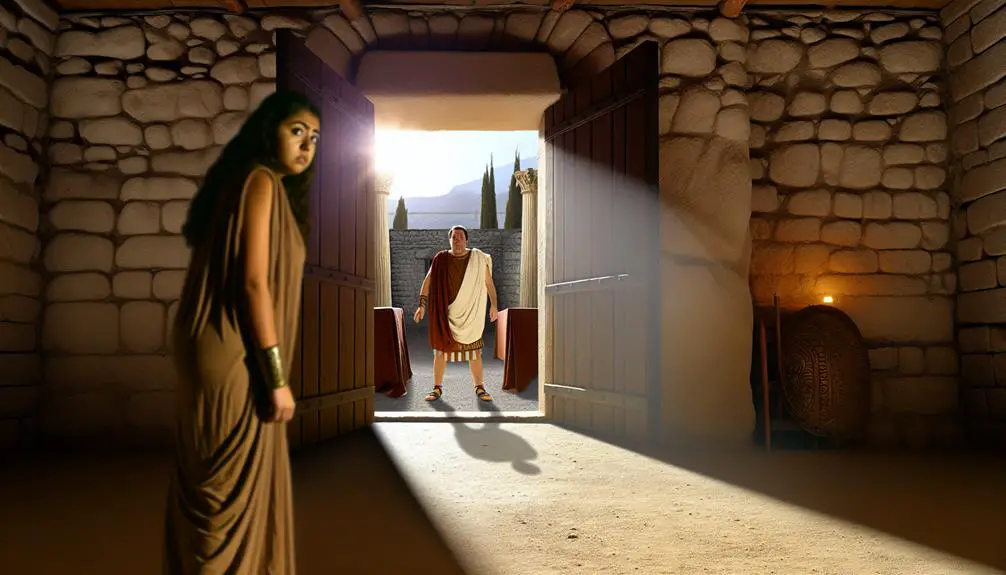The enigmatic wife of Pontius Pilate warns of a haunting dream, beckoning readers into the shadows of biblical mystery and historical intrigue.

Pontius Pilate's Wife in the Bible
In the shadows of historical accounts, you'll find Pontius Pilate's wife, a figure who briefly emerges in the biblical narrative with a message that reverberates through time. You're likely familiar with her husband, the Roman governor whose decision played a pivotal role in one of history's most significant events.
Yet, her brief appearance, armed with a prophetic warning, offers a tantalizing glimpse into the unseen influences at play. As you explore her story, consider the layers of interpretation and the gaps filled by scholars and theologians alike.
What might her warning and identity reveal about the broader historical and cultural context of the time? Let's uncover the underexplored significance of this enigmatic figure together.
Key Takeaways
- Pontius Pilate's wife warned him against convicting Jesus based on a troubling dream she had.
- Her intervention reflects the importance of dreams and divine warnings in biblical narratives.
- She challenges traditional gender roles by exerting influence over a significant political decision.
- Her story illustrates the intersection of personal intuition, spiritual insight, and political action in ancient Rome.
The Biblical Account

In the Christian New Testament, Pontius Pilate's wife emerges briefly yet memorably, as she sends a message to her husband urging him to have nothing to do with the trial of Jesus, based on a troubling dream she experienced. This incident opens a window into the complex interplay of dream interpretation and gender roles within the biblical narrative. Her involvement, although minimal in terms of textual space, offers a unique lens through which to analyze the societal expectations and limitations placed upon women in religious texts.
Dream interpretation, a recurrent motif in biblical stories, is traditionally seen as a means through which divine messages are communicated to humans. The act of a woman interpreting a dream and acting upon it disrupts conventional gender roles, presenting her as a figure of spiritual insight and agency. However, the text doesn't dwell on her interpretive act; instead, it focuses on her warning to Pilate. This brief narrative moment subtly challenges traditional gender expectations by attributing significant spiritual discernment and influence to a female character, even as it confines her to the private sphere of influence through her direct appeal to her husband.
Identity and Historical Background
Exploring the identity and historical background of Pontius Pilate's wife enriches our understanding of her brief yet impactful appearance in the New Testament. Her presence, though fleeting, opens a window into the complex interplay of Roman traditions and early Christian narratives.
- Roman Traditions: Pontius Pilate's wife emerges from a society deeply steeped in rituals and beliefs that often sought guidance from dreams. The Romans held dream analysis in high regard, considering dreams as messages from the divine or omens of future events. This cultural backdrop is crucial for comprehending the significance of her warning to Pilate, based on a dream.
- Historical Context: The historical records beyond the biblical account provide scant details about her. This lack of information has led scholars to piece together her identity from the broader societal roles of women in Roman governance and their involvement in religious practices.
- Literary Analysis: Her mention in the Gospel of Matthew isn't just a narrative detail but a reflection of the intertwined nature of personal belief systems and public decision-making processes in Roman society.
- Cultural Significance: Understanding her role involves recognizing the influence of Roman traditions on the interpretation of dreams and the weight such interpretations carried in personal and political decisions. This exploration into dream analysis within Roman culture sheds light on the potentially profound impact of her intervention in the biblical story.
The Warning to Pilate

A pivotal moment within the New Testament narrative is the warning issued by Pontius Pilate's wife, urging him to reconsider his decision regarding Jesus Christ based on a distressing dream she experienced. This brief yet profound episode underscores the significance of dreams and their interpretation within the ancient context, particularly as they pertain to decision-making processes of historical figures. Her intervention highlights the intersection between personal intuition, divine warnings, and political actions, suggesting a complex framework in which Pilate's decision was being scrutinized not only by his contemporaries but also by unseen, divine forces through the medium of dreams.
The account of Pilate's wife's dream and her subsequent warning serves as a rare instance in the biblical texts where a woman directly influences a critical moment in the narrative surrounding Jesus Christ's trial and crucifixion. It raises intriguing questions about the role of dreams in guiding leaders' decisions and the weight such spiritual insights held in ancient governance. Her warning is a stark reminder of the unseen dimensions that interplay with historical events, framing Pilate's decision in a context that transcends mere political judgment and enters the realm of moral and spiritual dilemma.
Interpretations and Theories
Scholars often debate the significance and interpretation of Pontius Pilate's wife's dream, offering various theories that aim to unravel its historical and theological implications. These interpretations not only dissect the dream's content but also probe into the broader context of gender roles within biblical narratives.
- Divine Warning: Some argue that the dream served as a divine intervention, meant to warn Pilate against the wrongful conviction of Jesus, thus emphasizing the spiritual realm's influence over earthly matters.
- Historical Contextualization: Others view the dream through a historical lens, suggesting it reflects common beliefs of the time regarding dreams as omens or messages from the divine, thereby providing insights into contemporary Judeo-Christian thoughts on premonitions.
- Gender Dynamics: The inclusion of Pilate's wife introduces a rare female perspective in the biblical narrative, challenging traditional gender roles by positioning a woman as the bearer of divine wisdom, albeit indirectly.
- Psychological Interpretation: Some scholars analyze the dream from a psychological standpoint, considering it a manifestation of the collective anxiety surrounding Jesus's trial and crucifixion, thus underscoring the human psyche's response to impending crisis.
These theories highlight the multifaceted interpretations of dream narratives and their role in exploring gender dynamics within biblical texts.
Legacy and Cultural Impact

Building on the multifaceted interpretations of Pilate's wife's dream, we now examine its enduring legacy and cultural impact, reflecting on how this narrative has influenced artistic and theological discourses through the ages. Dream interpretations connected to Pilate's wife have spurred a wide array of scholarly debates, each aiming to unearth the symbolic meaning behind her divine warning. This quest for understanding hasn't only enriched theological studies but also inspired a myriad of artistic representations. These works span various mediums, from classical paintings to modern digital art, each interpreting the dream's significance in unique and compelling ways.
The cultural footprint of Pilate's wife's dream extends beyond the confines of religious and academic circles. It has permeated popular culture, influencing literature, film, and theater, showcasing the timelessness of her story. This narrative's ability to evoke empathy and provoke contemplation on moral responsibility and divine intervention speaks to its universal appeal. Consequently, her story continues to resonate with audiences, serving as a poignant reminder of the complexities of human conscience and the profound impact of heeding or ignoring spiritual warnings. Through this lens, the legacy of Pilate's wife's dream persists, cementing its place in both historical and contemporary discourse.
Frequently Asked Questions
What Role Does Pontius Pilate's Wife Play in Non-Canonical Christian Texts or Apocryphal Gospels?
In non-canonical Christian texts, Pontius Pilate's wife is often depicted as experiencing prophetic dreams that significantly impact her perspective on Jesus' trial. Her dream interpretations offer a unique lens through which the events are viewed, showcasing her apocryphal influence.
These texts provide a deeper exploration of her character, suggesting she played a more substantial role in the narrative than is acknowledged in canonical scriptures, elevating her significance in early Christian traditions.
Are There Any Existing Artistic or Literary Works From the Early Christian Period That Depict or Mention Pontius Pilate's Wife?
Yes, you'll find the needle in the haystack.
Early Christian period art and literature occasionally feature Pontius Pilate's wife, though she's not a central figure. These works often explore her dream interpretation and its cultural symbolism, providing a unique lens through which to view early Christian narratives.
Scholars analyze these depictions to understand the broader societal values and beliefs of the time, highlighting her role in a sophisticated, analytical manner.
How Do Different Christian Denominations Today View or Commemorate Pontius Pilate's Wife, if at All?
Different Christian denominations today have varied interpretations and commemorations of Pontius Pilate's wife, focusing on her dream and its implications. Some view her as a figure of spiritual insight, interpreting her dream as a divine warning.
Few traditions, notably the Ethiopian Orthodox Church, honor her with a feast day, recognizing her attempt to intervene. However, many denominations don't specifically commemorate her, leaving her largely a peripheral figure in Christian teachings.
Has Recent Archaeological Evidence or Historical Scholarship Shed New Light on the Social Status and Lifestyle of Roman Governors' Wives in Judea During Pontius Pilate's Governance?
Yes, recent scholarly work and archaeological findings have indeed illuminated the lifestyles of Roman governors' wives in Judea, including during Pilate's tenure.
You'd find that Roman architecture and Pilate's policies significantly influenced their social standing and daily lives.
These discoveries offer insights into their roles and the extent of their influence within the governance structure, providing a richer understanding of their contributions and challenges in a historically complex period.
Are There Any Modern Novels, Films, or Plays That Prominently Feature Pontius Pilate's Wife, and How Do These Interpretations Compare With Her Biblical Portrayal?
You'll find modern retellings in novels, films, and plays where Pontius Pilate's wife emerges from the shadows, her character development taking center stage. These interpretations juxtapose her brief biblical mention with rich narrative layers, revealing cultural interpretations that diverge and converge with ancient texts.
Such portrayals invite you to analyze her role through a contemporary lens, offering insights into the evolving perceptions of historical figures within modern storytelling.
Conclusion
In conclusion, the enigmatic figure of Pontius Pilate's wife, veiled in the shadows of antiquity, serves as a pivotal yet understated beacon in biblical narratives. Her fleeting appearance whispers a cautionary tale, intertwining divine foresight with human agency.
This analysis peels back layers of historical and theological interpretation, revealing her legacy as not merely a footnote, but a crucial crossroads in the tapestry of cultural and religious discourse.
Her story, a subtle nudge in the annals of history, continues to intrigue and inspire scholarly exploration.



Sign up